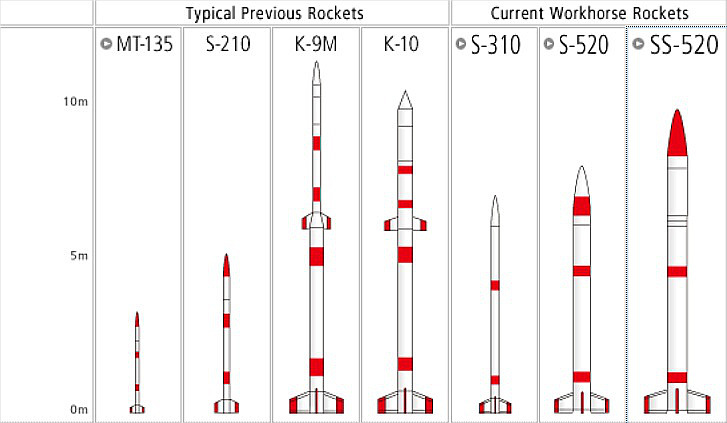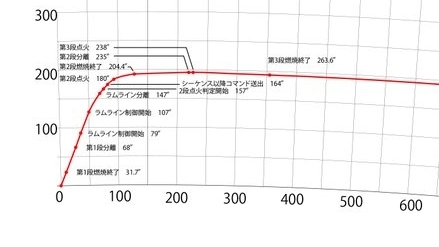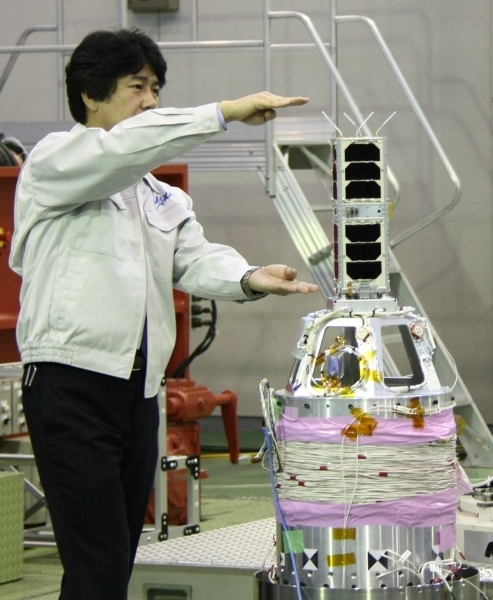Simple ultralight rockets something unlucky

In recent years, a new class of launch vehicles has been formed - ultralight, very simple, and starting from rail guides. And something is unlucky for them - at the end of 2015, the first launch of the American Super Strypi RN ended with an accident, and on January 14 of this year the launch of the Japanese SS-520-4 rocket unsuccessfully launched into a space rocket. The future of both projects is uncertain, and it is a pity that interesting technical solutions are used there, and this type of launch vehicle can theoretically find its niche.
Start January 14
Initially, they wanted to launch the rocket on January 10, but the start was postponed due to bad weather - the wind speed exceeded the maximum allowable values. On January 14, on a clear morning at 8:33 local time, the rocket started off beautifully with a guide.
')
In the first minutes the information was contradictory - some news agencies reported a successful launch, some wrote about the loss of telemetry. But rather quickly the situation became clear - the telemetry from the rocket disappeared for 20 seconds, and without it, the ground control center did not give the command to start the second-stage engine. Having risen to 200 km, the payload booster fell into the Pacific Ocean.
Design, cyclogram and payload
The SS-520-4 launch vehicle is a modification of the SS-520 rocket from the whole S-family of Japanese geophysical rockets.

Photo: Wikipedia
Geophysical S-520 is able to lift up to 100 kg of cargo to an altitude of 300 km and provide at least five minutes of weightlessness for the payload. It was first launched in 1980 and last launched in 2015. Adding the second stage to the S-520, the Japanese space agency received the SS-520, which could already lift 140 kg to an altitude of 1000 km. In this version, the rocket was successfully launched in 1998 from the Utinoura cosmodrome (also called Kagoshima by the name of the prefecture where it is located) and in 2000 from the Svalbard testing ground in Norway. The SS-520-4 is, in fact, the designation of the launch number, and not a separate type of launch vehicle (to make it even funnier, the suborbital launch SS-520-3 has not yet taken place), but this time the rocket was set three stages and dropped orientation block.

Photo: JAXA
The launch pattern for the launch vehicle was planned quite unusual.
The first stage S-520, with a diameter of 0.52 m and a length of 6.1 meters, develops an average thrust of 14.6 tons. With a total rocket mass of 2.6 tons, the initial acceleration was 5.6 "same", and it only increased with the development of fuel and rocket relief. The first stage engine worked for 31 seconds, spent 1587 kg of solid fuel, during this time it accelerated the rocket to 2 km / s and managed to lift to a height of 26 km. At the same time, the first stage did not have its own control system, it was induced by a tilt-and-lift ramp of the launching device and was spun by tail stabilizers in flight, using rotation to stabilize the flight.
At 67 seconds of flight and an altitude of 81 km, the head fairing should have been reset. A second later, the first step separates. Starting from 79 seconds (height 97 km), it was planned to activate the orientation system on compressed gas. Eating from a 5.7-liter tank with compressed nitrogen, pulsed gas engines first introduced the second and third stages into precession , and, through it, had to turn the bundle into a horizontal position. At 107 seconds, the orientation block terminated and dropped forty seconds later.
At 157 seconds, the ground control center had to manually decide whether to give a command for further inference. If everything went well, this command should have been sent in 164 seconds. At 180 seconds, when the speed of the rocket would have dropped to a kilometer per second, and the height would increase to 179 km, the second stage engine would start. The second stage, 1.7 meters long, with 325 kg of fuel, should have accelerated the rocket to 3.6 km / s in 24.4 seconds. At 235 seconds, it would have dropped, and, after 3 seconds, the third stage (length 0.8 m, 78 kg of solid fuel on board) would turn on, which would accelerate the payload to 8.1 km / s. As a result, a satellite weighing 3 kg was to go into orbit 180x1500 km in just over four minutes, although satellites deduce satellites in about ten minutes. At the same time, the second and third stages did not have a full-fledged control system, stabilized by rotation, and the third stage did not even have full telemetry channels — a small GPS module was installed on it, which, through Iridium communication satellites, had to report altitude and speed data.
The inference profile also turned out to be unusual - the start was abruptly towards the horizon, and then the payload would move almost horizontally.

The launch vehicle had an initial mass of 2.6 tons, which makes it one of the lightest space launch vehicles in the history of astronautics. For comparison, the Super Strypi weighed 28 tons.
The payload was a cubic 3U TRICOM-1 format with six cameras for Earth observation.

Photo: JAXA
Foggy future
Despite the simplicity of the technology used, Japan spent $ 3.5 million on SS-520-4. It was expected that subsequent launches would be cheaper, but it is not yet known whether the program SS-520 will develop, and if so, how. For comparison, Super Strypi has spent $ 45 million since 2007, and, as of 2016, the project is hanging in the air - it is not completely closed, but no money is allocated for new missiles, and it is not known whether it will be allocated.
However, the very principle of an ultralight launch vehicle for launching nanosatellites may well have potential. The first Kubsatas were launched in 2003, in recent years more than three hundred Kubsatov of different formats were displayed, and in the manifesto only for 2017 they are already in the region of two hundred. Nanosatellites are confidently moving to the applied level from student and experimental devices. As a rule, they are now being launched by passing loads with a “regular” satellite or in large groups, and the market value of the launch is estimated at $ 250,000 per cubic meter of 3U format (3 blocks 10x10x11.35 cm). Theoretically, the customer can pay more for the possibility of quickly removing his cubsat into a separate orbit. This is where a niche can be found for simple launch vehicles that:
- Use solid fuel, which is easier and cheaper to handle.
- Minimize the number of electronics - start from the ramp, stabilized by rotation and do not use control systems at all levels.
- Reduce indirect costs by reducing maintenance staff, reducing size and simplifying maintenance.
If there is a company that can overcome the problems posed by these technical solutions (for example, the Super Strypi first-tier engine could not stand the rotation), survive the first failures and can reduce the launch price, then such ultra-light launch vehicles can become popular in the growing market nanosatellites.
Source: https://habr.com/ru/post/400831/
All Articles